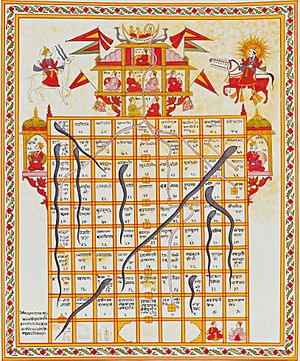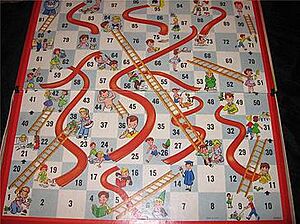Snakes and ladders facts for kids

Game of Snakes and ladders, gouache on cloth (India, 19th century)
|
|
| Years active | Ancient India 2nd century AD to present |
|---|---|
| Genre(s) | Board game Race game Dice game |
| Players | 2 or more |
| Setup time | Negligible |
| Playing time | 15–45 minutes |
| Random chance | Complete |
| Skill(s) required | Counting, observation |
| Synonym(s) | Moksha Patam Chutes and Ladders |
Snakes and Ladders is a super old board game that started in Ancient India. It was first called Moksha Patam. Today, people all over the world play it!
The game is played on a board with numbered squares. You'll see "ladders" and "snakes" drawn on the board. Each one connects two different squares. Your goal is to move your game piece from the start (usually the bottom) to the finish (the top). Ladders help you climb up, but snakes make you slide down!
It's mostly a game of luck, which makes it fun for younger kids. Long ago, the game was used to teach lessons about good and bad choices. Climbing a ladder meant you did something good, while sliding down a snake meant you made a bad choice. Today, you might know it as Chutes and Ladders.
Contents
How to Play Snakes and Ladders
The game board can be different sizes, like 8x8, 10x10, or 12x12 squares. The number of snakes and ladders, and where they are, changes how long the game takes. Each player has their own special game piece. You usually roll one die to move your piece. Sometimes, two dice are used to make the game faster.
Starting the Game
Each player puts their game piece on the starting square. This is usually the "1" square at the bottom left. Or, you might start just off the board next to the "1" square. Players take turns rolling the die. You move your piece the number of squares shown on the die.
Moving Your Piece
Your game piece follows a path on the board. This path usually goes back and forth, like an ox plowing a field. It moves from the bottom of the board all the way to the top.
- If your piece lands on the bottom of a ladder, you get to move it up to the top of that ladder!
- If your piece lands on the head of a snake (or a chute), you have to slide it down to the snake's tail.
If you roll a "6", you get to move your piece and then roll the die again for another turn! If you roll any other number, play moves to the next person. The first player to reach the very last square on the board wins the game!
Different Ways to Play
Some versions of the game have special rules for winning. You might need to roll the exact number to land on the final square. If your roll is too high, your piece might stay put. Or, it might move forward and then bounce back the extra spaces. For example, if you need a "3" to win but roll a "5", you move three spaces forward and then two spaces back. This can sometimes make you further away from winning!
There's even a version called Adders-and-Ladders that needs skill, not just luck. In this game, all players share the same game pieces. Instead of rolling a die, you choose a piece and move it 1 to 4 spaces. The player who moves the last piece to the "Home" square wins!
Popular Versions of the Game
The most famous version in the United States is Chutes and Ladders. Milton Bradley released it in 1943. They changed the snakes into "chutes" because kids didn't like snakes as much. This game is played on a 10x10 board. Instead of a die, players use a spinner to move. The board shows kids playing on a playground, climbing ladders and sliding down chutes.
The pictures on the board teach good lessons. At the bottom of a ladder, you see a child doing something good. At the top, they get a reward! At the top of a chute, you see kids doing something naughty. At the bottom, they face the results of their actions.
Over the years, many different versions have come out. Some feature popular TV characters like Dora the Explorer or Sesame Street. In Canada, the game is still called "Snakes and Ladders." Some Canadian versions even have toboggan runs instead of snakes!
Learning with Snakes and Ladders
Even though the old lessons about good and bad aren't always in the modern games, Snakes and Ladders is still a great learning tool.
- In Indonesia, playing the game helped fifth graders learn new English words. It also made learning more fun and exciting for them!
- Researchers found that young children who played number board games like Snakes and Ladders got better at counting. They also improved at recognizing number shapes.
- There's even an eco-friendly version of the game. It helps students and teachers learn about climate change and how to protect our environment.
Snakes and Ladders in Pop Culture
- The saying "back to square one" might have come from this game. It means you have to start all over again.
- In the book Midnight's Children, the game is used as a big idea. It shows how life has ups and downs, good and bad.
- The TV show SpongeBob SquarePants has a funny version called "Eels and Escalators."
- There's a board game cafe chain in Canada called Snakes & Lattes. It's named after the game!
- In an episode of Abby Hatcher, characters play a video game version of Snakes and Ladders. They even use their bodies to act out the game!
- The band AC/DC mentions the game in their song Sin City: "Ladders and snakes, Ladders give, Snakes take..."
- Joni Mitchell has a song called "Snakes and Ladders" on her 1988 album.
Images for kids
-
Gyan chaupar (Jain version of the game), National Museum, New Delhi
See also
 In Spanish: Serpientes y escaleras para niños
In Spanish: Serpientes y escaleras para niños



